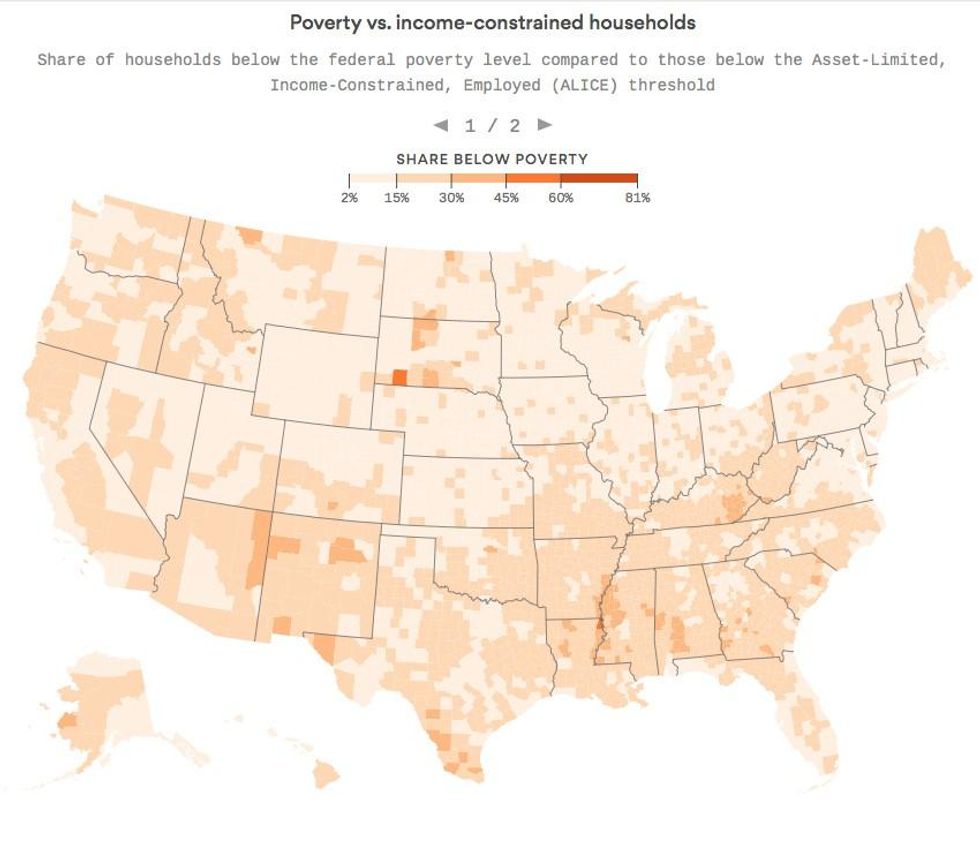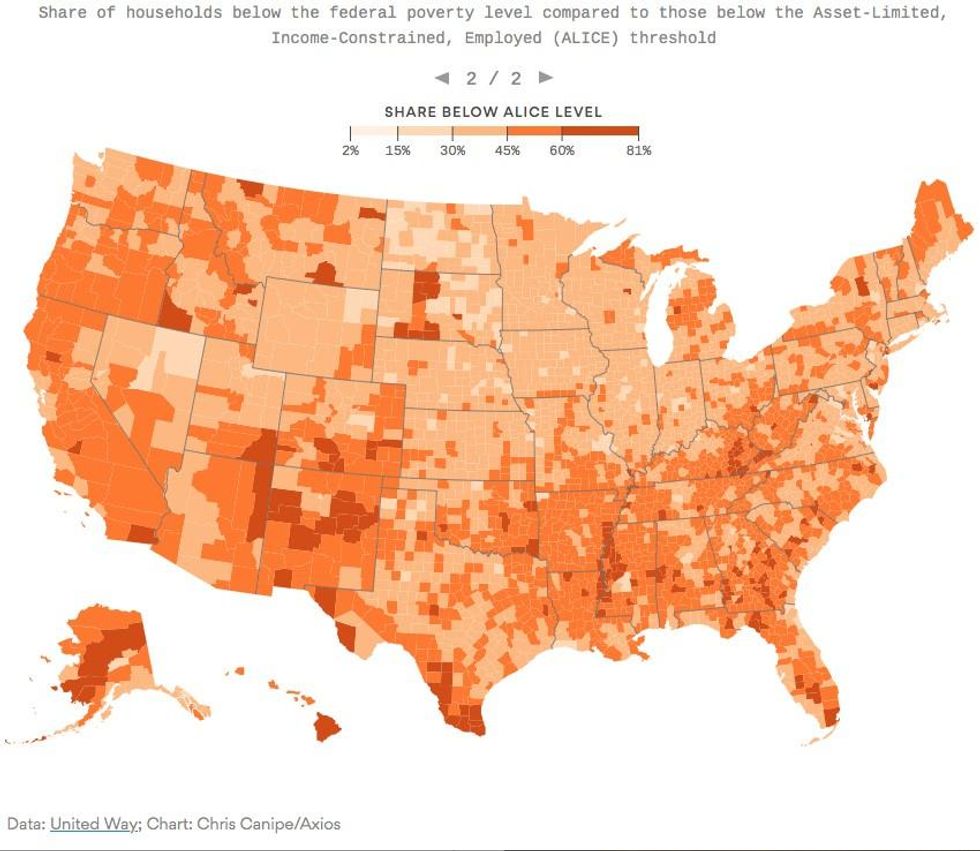

SUBSCRIBE TO OUR FREE NEWSLETTER
Daily news & progressive opinion—funded by the people, not the corporations—delivered straight to your inbox.
5
#000000
#FFFFFF
To donate by check, phone, or other method, see our More Ways to Give page.


Daily news & progressive opinion—funded by the people, not the corporations—delivered straight to your inbox.

A new study from United Way found 43 percent of U.S. households struggle to afford basic expenses. (Photo: Len Tsou/Flickr/cc)
"Is that really the kind of society we want to be living in?"
That's how Sen. Bernie Sanders (I-Vt.) responded to a new study from United Way's ALICE Project, which found that 43 percent of U.S. households--nearly 51 million families--cannot afford "a bare-bones household budget of housing, child care, food, transportation, and healthcare."
\u201cThe three wealthiest people in America own more wealth than the bottom 50 percent\u200a\u2014\u200aover 160 million people. Meanwhile, almost half of families in America can't afford basic necessities. Is that really the kind of society we want to be living in? https://t.co/AVEuUHuxU3\u201d— Bernie Sanders (@Bernie Sanders) 1526654181
Sanders has long advocated for policies to serve these households. The senator is working on a plan that would establish a federal jobs guarantee, and during the current session of Congress, he has introduced legislation that would strengthen trade unions and ensure healthcare for all Americans through a "Medicare for All" model.
ALICE--which stands for Asset Limited, Income Constrained, Employed--is a term United Way developed to describe the population that is above the federal poverty level but still struggling to pay for basic expenses. In addition to the 16.1 million American families living below the poverty line, 34.7 million U.S. households fit the group's ALICE classification.
"People are struggling to make their ends meet. Not hard to see why problematic substance use and suicide are at crisis levels," tweeted Leo Beletsky, a professor of law and public health at Northeastern University.
\u201cPeople are struggling to make their ends meet. Not hard to see why problematic substance use and suicide are at crisis levels h/t @UnitedWay ALICE study https://t.co/wu30Y5o2rA\u201d— Leo Beletsky \ud83c\udf08 (@Leo Beletsky \ud83c\udf08) 1526630019
"Many of these folks are the nation's child care workers, home health aides, office assistants, and store clerks, who work low-paying jobs and have little savings," CNN reported. "California, New Mexico, and Hawaii have the largest share of struggling families, at 49 percent each."
Project director Stephanie Hoopes told CNN that "despite seemingly positive economic signs, the ALICE data shows that financial hardship is still a pervasive problem."
The study, Axiosnoted, "suggests that the economically forgotten are a far bigger group than many studies assume," and according to Hoopes, that group seems to be growing.
"It's a magnitude of financial hardship that we haven't been able to capture until now," she said.
In a pair of graphics, Axios showed how the official federal poverty level fails to accurately measure the number of U.S. families that cannot afford basic costs of living.


Trump and Musk are on an unconstitutional rampage, aiming for virtually every corner of the federal government. These two right-wing billionaires are targeting nurses, scientists, teachers, daycare providers, judges, veterans, air traffic controllers, and nuclear safety inspectors. No one is safe. The food stamps program, Social Security, Medicare, and Medicaid are next. It’s an unprecedented disaster and a five-alarm fire, but there will be a reckoning. The people did not vote for this. The American people do not want this dystopian hellscape that hides behind claims of “efficiency.” Still, in reality, it is all a giveaway to corporate interests and the libertarian dreams of far-right oligarchs like Musk. Common Dreams is playing a vital role by reporting day and night on this orgy of corruption and greed, as well as what everyday people can do to organize and fight back. As a people-powered nonprofit news outlet, we cover issues the corporate media never will, but we can only continue with our readers’ support. |
"Is that really the kind of society we want to be living in?"
That's how Sen. Bernie Sanders (I-Vt.) responded to a new study from United Way's ALICE Project, which found that 43 percent of U.S. households--nearly 51 million families--cannot afford "a bare-bones household budget of housing, child care, food, transportation, and healthcare."
\u201cThe three wealthiest people in America own more wealth than the bottom 50 percent\u200a\u2014\u200aover 160 million people. Meanwhile, almost half of families in America can't afford basic necessities. Is that really the kind of society we want to be living in? https://t.co/AVEuUHuxU3\u201d— Bernie Sanders (@Bernie Sanders) 1526654181
Sanders has long advocated for policies to serve these households. The senator is working on a plan that would establish a federal jobs guarantee, and during the current session of Congress, he has introduced legislation that would strengthen trade unions and ensure healthcare for all Americans through a "Medicare for All" model.
ALICE--which stands for Asset Limited, Income Constrained, Employed--is a term United Way developed to describe the population that is above the federal poverty level but still struggling to pay for basic expenses. In addition to the 16.1 million American families living below the poverty line, 34.7 million U.S. households fit the group's ALICE classification.
"People are struggling to make their ends meet. Not hard to see why problematic substance use and suicide are at crisis levels," tweeted Leo Beletsky, a professor of law and public health at Northeastern University.
\u201cPeople are struggling to make their ends meet. Not hard to see why problematic substance use and suicide are at crisis levels h/t @UnitedWay ALICE study https://t.co/wu30Y5o2rA\u201d— Leo Beletsky \ud83c\udf08 (@Leo Beletsky \ud83c\udf08) 1526630019
"Many of these folks are the nation's child care workers, home health aides, office assistants, and store clerks, who work low-paying jobs and have little savings," CNN reported. "California, New Mexico, and Hawaii have the largest share of struggling families, at 49 percent each."
Project director Stephanie Hoopes told CNN that "despite seemingly positive economic signs, the ALICE data shows that financial hardship is still a pervasive problem."
The study, Axiosnoted, "suggests that the economically forgotten are a far bigger group than many studies assume," and according to Hoopes, that group seems to be growing.
"It's a magnitude of financial hardship that we haven't been able to capture until now," she said.
In a pair of graphics, Axios showed how the official federal poverty level fails to accurately measure the number of U.S. families that cannot afford basic costs of living.


"Is that really the kind of society we want to be living in?"
That's how Sen. Bernie Sanders (I-Vt.) responded to a new study from United Way's ALICE Project, which found that 43 percent of U.S. households--nearly 51 million families--cannot afford "a bare-bones household budget of housing, child care, food, transportation, and healthcare."
\u201cThe three wealthiest people in America own more wealth than the bottom 50 percent\u200a\u2014\u200aover 160 million people. Meanwhile, almost half of families in America can't afford basic necessities. Is that really the kind of society we want to be living in? https://t.co/AVEuUHuxU3\u201d— Bernie Sanders (@Bernie Sanders) 1526654181
Sanders has long advocated for policies to serve these households. The senator is working on a plan that would establish a federal jobs guarantee, and during the current session of Congress, he has introduced legislation that would strengthen trade unions and ensure healthcare for all Americans through a "Medicare for All" model.
ALICE--which stands for Asset Limited, Income Constrained, Employed--is a term United Way developed to describe the population that is above the federal poverty level but still struggling to pay for basic expenses. In addition to the 16.1 million American families living below the poverty line, 34.7 million U.S. households fit the group's ALICE classification.
"People are struggling to make their ends meet. Not hard to see why problematic substance use and suicide are at crisis levels," tweeted Leo Beletsky, a professor of law and public health at Northeastern University.
\u201cPeople are struggling to make their ends meet. Not hard to see why problematic substance use and suicide are at crisis levels h/t @UnitedWay ALICE study https://t.co/wu30Y5o2rA\u201d— Leo Beletsky \ud83c\udf08 (@Leo Beletsky \ud83c\udf08) 1526630019
"Many of these folks are the nation's child care workers, home health aides, office assistants, and store clerks, who work low-paying jobs and have little savings," CNN reported. "California, New Mexico, and Hawaii have the largest share of struggling families, at 49 percent each."
Project director Stephanie Hoopes told CNN that "despite seemingly positive economic signs, the ALICE data shows that financial hardship is still a pervasive problem."
The study, Axiosnoted, "suggests that the economically forgotten are a far bigger group than many studies assume," and according to Hoopes, that group seems to be growing.
"It's a magnitude of financial hardship that we haven't been able to capture until now," she said.
In a pair of graphics, Axios showed how the official federal poverty level fails to accurately measure the number of U.S. families that cannot afford basic costs of living.

